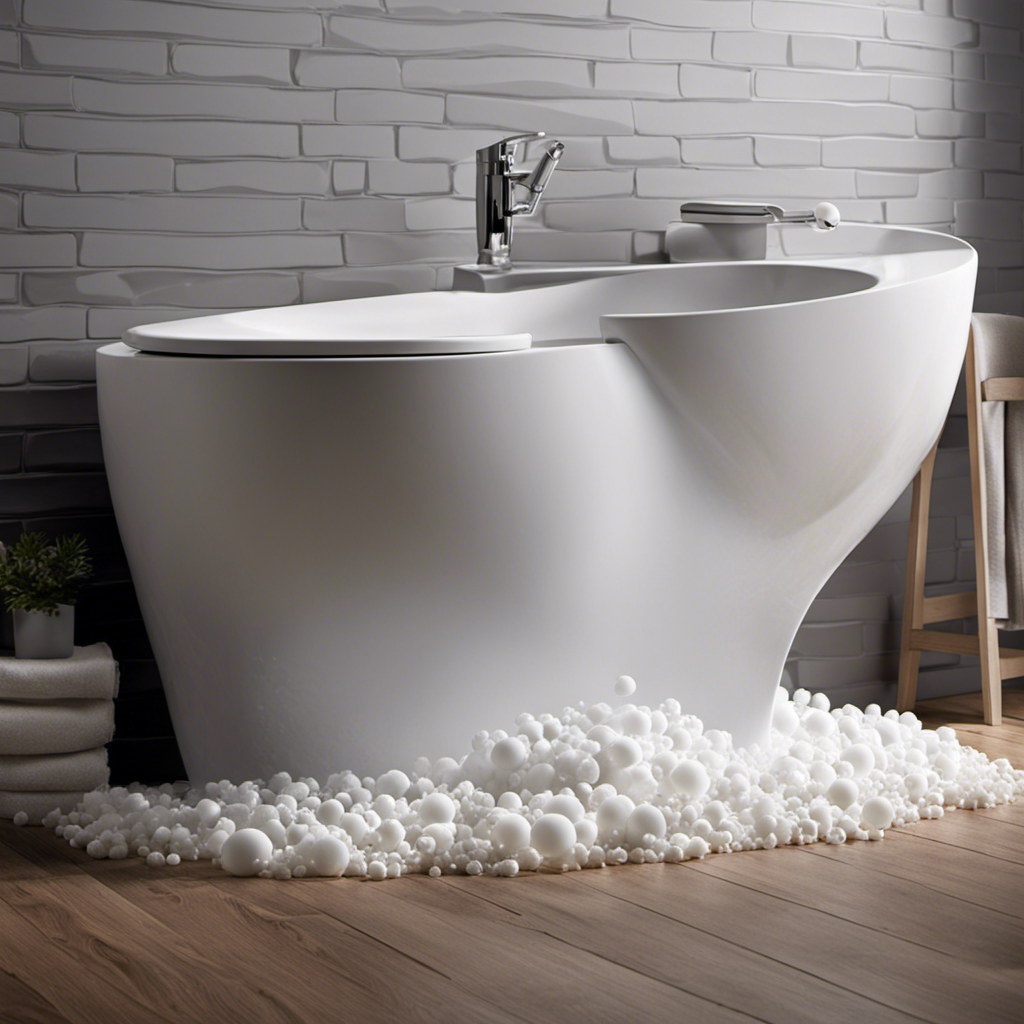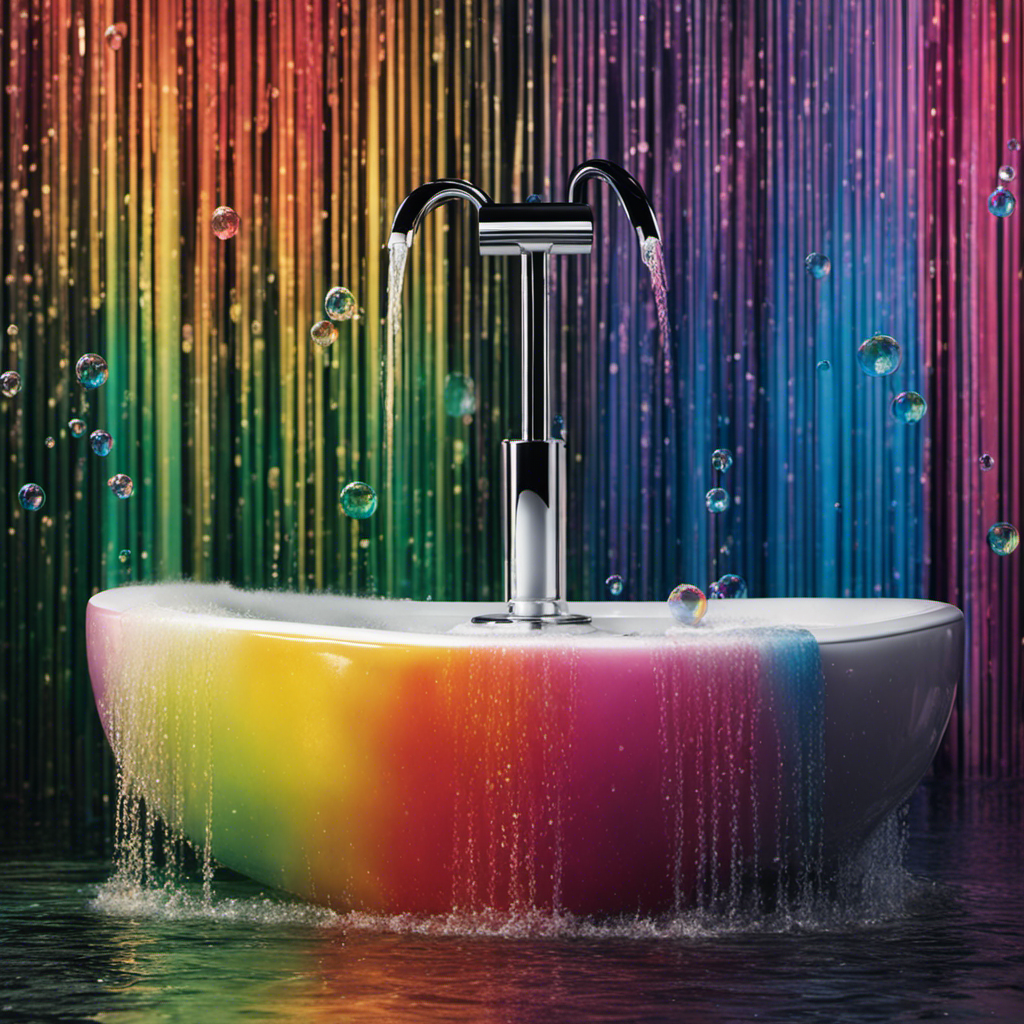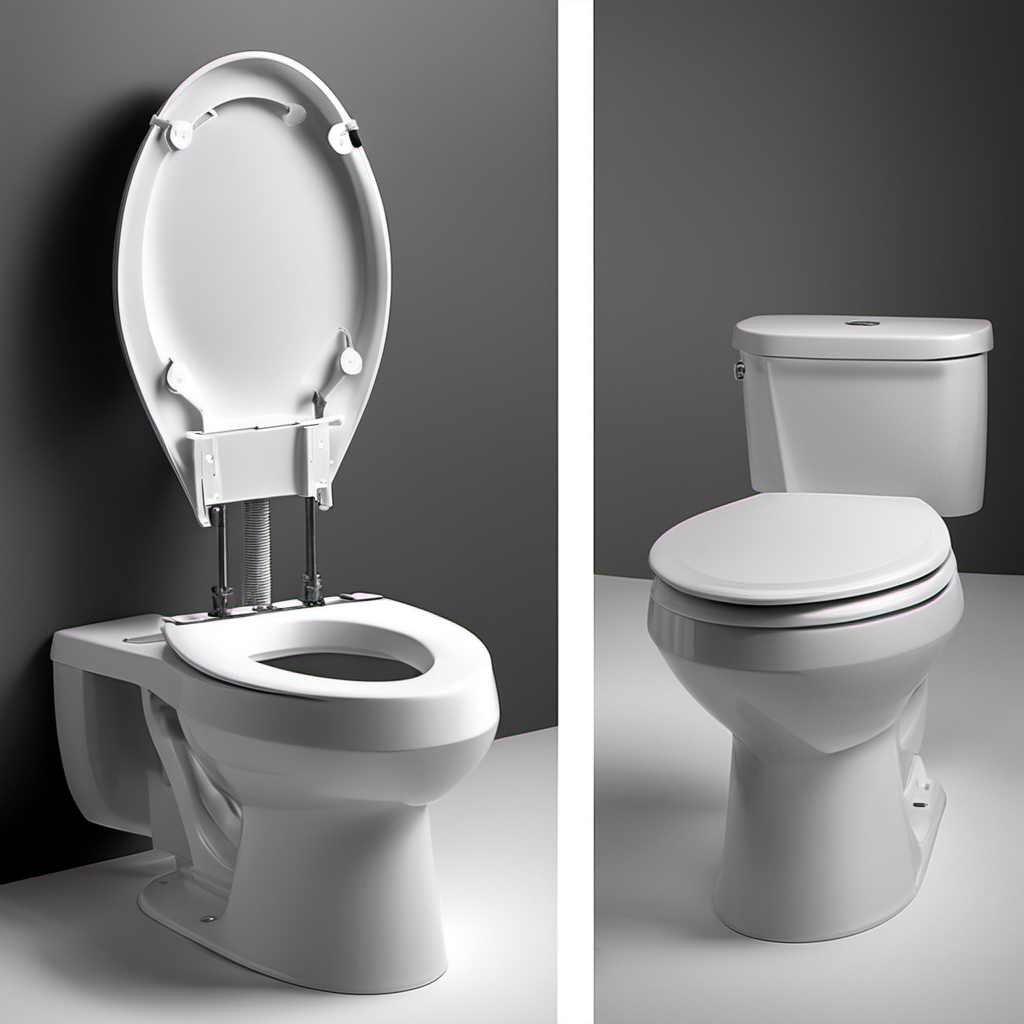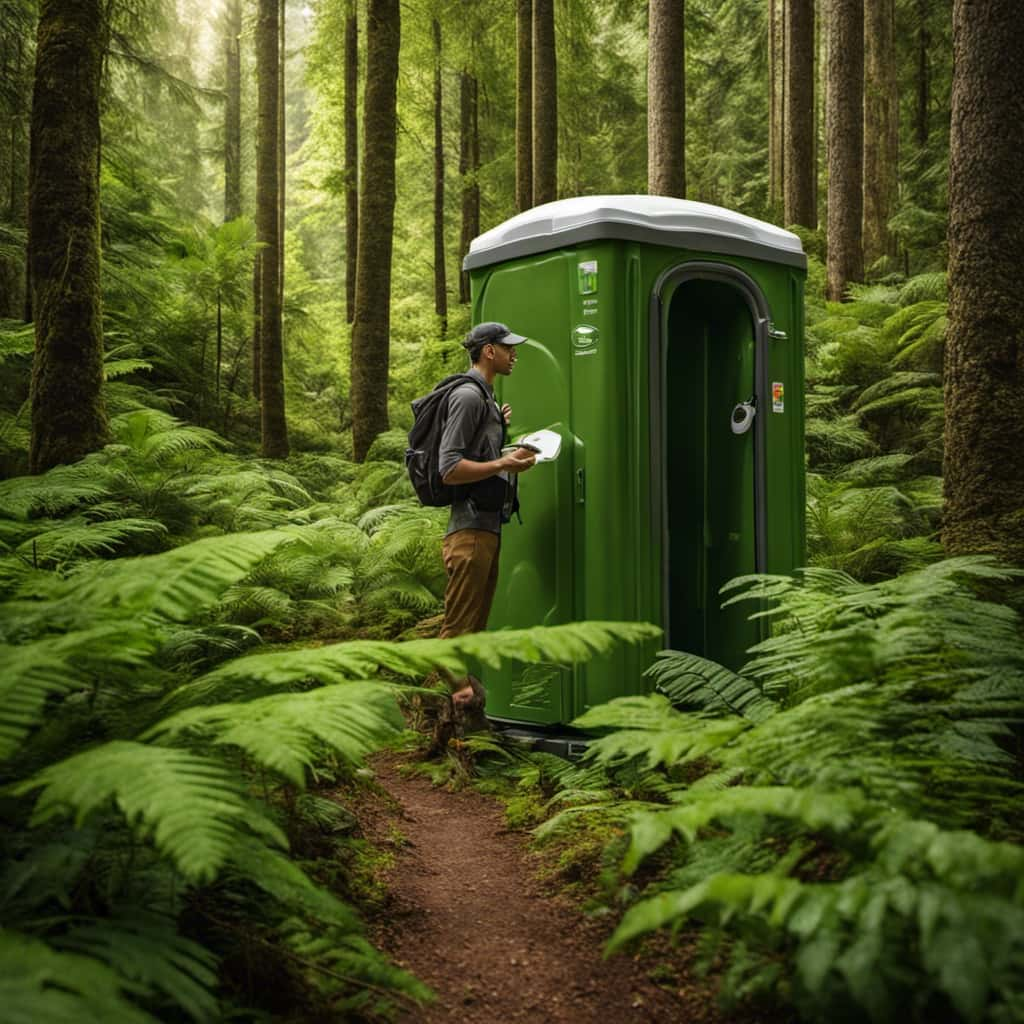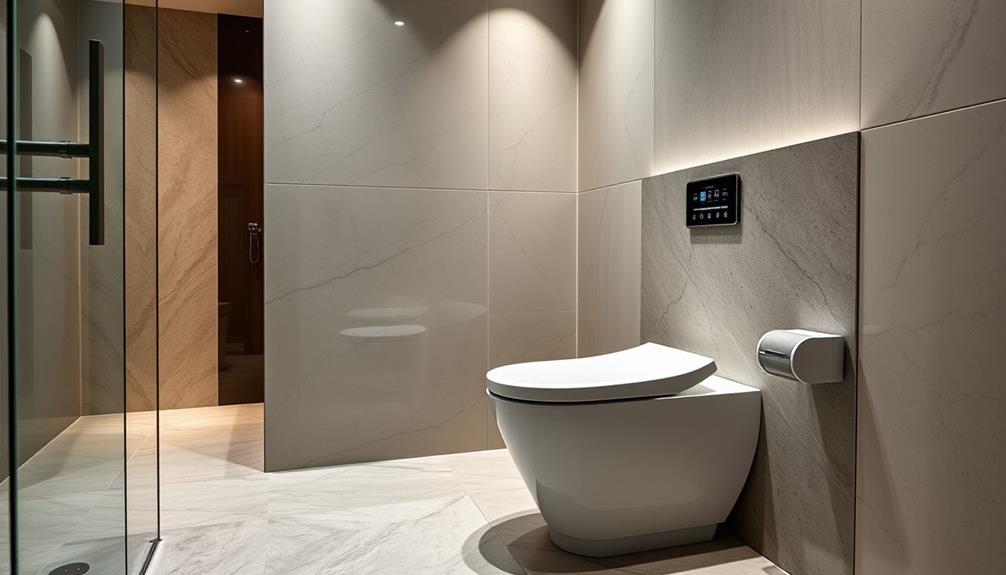When the washer drains, have you ever noticed bubbles forming in your toilet? It may seem like a harmless occurrence, but it could be a sign of underlying plumbing issues.
In this article, I will discuss the common causes of toilet bubbles when the washer drains, how to identify and fix these issues, as well as prevention tips to avoid future problems.
Additionally, I will provide information on professional plumbing services that can help address this concern.
Let’s dive into the world of toilet bubbles and get to the bottom of this puzzling phenomenon.
Key Takeaways
- Clogged vent pipes can cause negative pressure in the drainage system, leading to toilet bowl bubbles when the washer drains.
- Sewer line damage, such as cracks or leaks, can result in improper drainage and bubble formation in the toilet bowl.
- Regular maintenance and inspection can help prevent toilet bubbles and detect sewer line problems early.
- Drain blockage causes, such as debris, tree roots, grease buildup, and foreign objects, can lead to toilet bowl bubbles and should be identified for effective plumbing maintenance.
Common Causes of Toilet Bubbles When Washer Drains
One common cause of toilet bubbles when the washer drains is a clogged vent pipe.
The vent pipe is an essential component of a plumbing system as it allows air to flow in and out, maintaining proper pressure and preventing suction or airlock.
When the vent pipe gets clogged, it restricts the flow of air, leading to negative pressure in the drainage system.
This negative pressure can cause the water in the toilet bowl to bubble when the washer drains.
It is important to address this issue promptly to prevent further damage and ensure the smooth functioning of the plumbing system.
Signs of sewer line damage can include foul odors, slow drainage in multiple fixtures, and frequent clogs.
Regular maintenance and inspection can help in toilet bubble prevention and early detection of sewer line problems.
How to Identify Plumbing Issues Causing Toilet Bubbles
When it comes to identifying plumbing issues causing toilet bubbles, there are three key points to consider.
Firstly, drain blockage causes can include items such as hair, debris, or even tree roots obstructing the flow of water through the pipes.
Secondly, a malfunctioning venting system can lead to air pressure imbalances, causing bubbles to form in the toilet bowl.
Lastly, sewer line damage, such as cracks or leaks, can result in improper drainage and the formation of bubbles.
Drain Blockage Causes
If your toilet bubbles when the washer drains, it’s likely due to a blockage in the drain. A drain blockage can cause various issues in your plumbing system, including foul drain odors and slow drainage. Identifying the causes of drain blockage is crucial for effective plumbing maintenance.
Here are some common culprits:
-
Accumulation of debris: Over time, debris such as dirt, hair, and soap scum can build up in the drain, leading to blockages.
-
Tree root intrusion: Tree roots can infiltrate the drain pipes, causing obstructions and restricting the flow of water.
-
Grease buildup: Pouring grease down the drain can cause it to solidify and accumulate, resulting in blockages.
-
Foreign objects: Flushing non-flushable items down the toilet or allowing them to enter the drain can cause clogs.
Regular drain cleaning and proper disposal of waste can help prevent these blockages and maintain a healthy plumbing system.
Venting System Malfunction
The venting system may malfunction if there is a blockage in the drain. Proper venting system maintenance is crucial to ensure the smooth operation of your plumbing system.
Signs of a faulty venting system include gurgling sounds in drains, slow drainage, and foul odors coming from the drains. These issues occur because a blocked venting system prevents air from flowing freely through the plumbing system, causing water to drain slowly or create suction, leading to unpleasant smells.
To prevent venting system malfunctions, regular maintenance is necessary. This includes inspecting and clearing any debris or obstructions in the vent pipes. Additionally, ensuring that the vent pipes are properly installed and not damaged will help maintain the system’s functionality.
Proper venting system maintenance is essential in preventing sewer line damage, which we will discuss in the next section.
Sewer Line Damage
Regular maintenance is key to prevent sewer line damage. Neglecting maintenance can lead to costly repairs. Sewer line damage can be caused by various factors. These include tree roots infiltrating the pipes, old and deteriorating pipes, or blockages from debris.
It is important to be aware of the signs of sewer line damage. These signs include foul odors, slow drains, gurgling sounds, or sewage backups. If you notice any of these signs, it is crucial to take immediate action. This will prevent further damage and avoid potential health hazards.
Timely sewer line repair is essential. It restores proper functionality and prevents more extensive problems down the line.
Now, let’s move on to discuss the steps to take to fix toilet bubbles when the washer drains.
Steps to Take to Fix Toilet Bubbles When Washer Drains
First, you should check the drain vent to see if it’s clogged.
When your toilet bubbles while the washer drains, it is usually a sign of issues with the washer drain. This can be caused by a clogged drain vent, which prevents proper air flow and leads to air bubbles escaping through the toilet.
To fix this, locate the drain vent on your roof and inspect it for any obstructions. Use a flashlight to examine the vent and remove any debris or blockages that you find.
If the vent is clear, the problem may lie elsewhere, such as a partial blockage in the drain pipe. In such cases, it is recommended to seek professional help to properly diagnose and resolve the issue.
Prevention Tips for Avoiding Toilet Bubbles During Washer Drainage
One way to prevent air bubbles from escaping through the toilet when the washer drains is to regularly check and clear the drain vent. The drain vent plays a crucial role in allowing air to enter the plumbing system, preventing the formation of bubbles in the toilet.
By keeping the vent clear of any blockages or debris, you can ensure proper air flow and prevent bubbles from occurring.
Additionally, it is important to be aware of certain signs that may indicate plumbing issues causing toilet bubbles. These signs include gurgling sounds when the toilet flushes, slow draining sinks or showers, and foul odors coming from the drains.
If you notice any of these signs, it is recommended to contact a professional plumber to inspect and address the underlying plumbing problems.
Professional Plumbing Services to Address Toilet Bubbles
If you notice any signs of plumbing issues causing toilet bubbles, it’s best to contact a professional plumber to inspect and address the problem. Plumbing maintenance is crucial to prevent further damage and ensure the smooth functioning of your toilet.
A skilled plumber will have the knowledge and expertise to identify the root cause of the toilet bubbles and perform the necessary repairs. They can evaluate the drainage system, check for any blockages or leaks, and fix any faulty components. Whether it’s a problem with the venting system, a clog in the pipes, or a malfunctioning valve, a professional plumber will be able to diagnose and resolve the issue efficiently.
By seeking professional help for toilet repair, you can avoid potential complications and maintain the proper functioning of your plumbing system.
Now, let’s move on to troubleshooting other possible causes of toilet bubbles.
Troubleshooting Other Possible Causes of Toilet Bubbles
To address other possible causes of toilet bubbles, you should check the water supply valve and ensure it’s fully open. This is an important step in troubleshooting washing machine issues that can contribute to toilet bubbles.
In addition to checking the water supply valve, there are other factors to consider when it comes to toilet bubble prevention. Here are some key points to keep in mind:
- Inspect the washing machine drain hose for any clogs or kinks that may be causing improper drainage.
- Verify that the washing machine is level, as an unbalanced machine can lead to excessive vibrations and air being pushed into the toilet.
- Clean the washing machine lint trap regularly to prevent lint build-up, which can contribute to drain issues.
- Consider installing an air gap device between the washing machine drain and the toilet drain to prevent backflow.
Conclusion
In conclusion, dealing with toilet bubbles when the washer drains can be a frustrating and unpleasant experience. The sight of soapy water gurgling up from the toilet bowl can leave you feeling overwhelmed and disgusted.
However, by identifying the underlying plumbing issues and taking prompt action, you can put an end to this problem. Remember to follow the steps outlined and take preventive measures to avoid future occurrences.
And if all else fails, don’t hesitate to seek professional plumbing services. Don’t let toilet bubbles burst your bubble – take control and restore peace to your bathroom.
